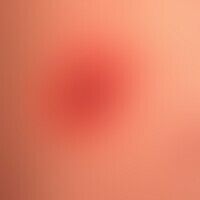Image diagnoses for "Plaque (raised surface > 1cm)", "red", "Leg/Foot"
125 results with 293 images
Results forPlaque (raised surface > 1cm)redLeg/Foot

Atopic dermatitis (overview) L20.-
flexural atopic eczema. skin changes in an 18-year-old girl with intermittent course since the age of 4 years. positive FA; EA: pollinosis known. in the area of the hollow of the knee blurred, reddened, little scaly, moderately itchy plaques. skin field coarsened (lichenification). classic finding of flexural eczema.

Acrodermatitis chronica atrophicans L90.4
Acrodermatitis chronica atrophicans. 78-year-old female patient with confirmed neuroborreliosis 6 years ago and still positive Borrelia serology. Multiple, chronically inpatient, persisting for 2 years, asymmetrical (only on the left leg), blurred, sometimes burning pain, large, red to red-livid, smooth erythema, partly with crinkled surface (cigarette-paper-like puckering).

Necrobiosis lipoidica L92.1
Necrobiosis lipoidica: bilateral, gradually increasing, moderately sharply defined, confluent, reddish-brownish, centrally slightly atrophic plaques that have existed for about several years.

Necrobiosis lipoidica L92.1
Necrobiosis lipoidica: different clinical sections. frontal, large, little indurated, slightly reddened plaque with atrophic surface. lateral a 3.5 cm diameter medal-shaped plaque with a slightly marginalized edge.

Erythema nodosum L52.0

Hypertrophic Lichen planus L43.81
Lichen planus verrucosus: Itchy (see scratching effects with crust formation),verrucous plaques on the left lower leg that have existed for years.

Larva migrans B76.9
Larva migrans, detail: Garland-shaped, tortuous, erythematous, partly scaly plaque on the right foot back of a 35-year-old patient after a bathing holiday in Thailand.

Erythema nodosum L52.0
Erythema nodosum: acute, multiple painful indurated plaques and nodules, accompanied by arthritis of the right ankle.

Atopic dermatitis (overview) L20.-
flexural atopic eczema. skin lesions in a 13-year-old girl with intermittent course since the age of 4 years. positive FA; EA: pollinosis known. in the area of the hollow of the knee blurred, reddened, slightly scaly, moderately itchy plaques. skin field coarsened (lichenification). classic finding of flexural eczema.

Erythema nodosum L52.0
erythema nodosum. multiple, blurred, very pressure painful, doughy, slightly raised, reddish-livid lumps. fever, fatigue and rheumatoid pain also occurred.

Papillomatosis cutis lymphostatica I89.0
Papillomatosis cutis lymphostatica, general view: Distally sharp, proximally blurred, confluent, yellowish-brownish, sometimes red, very firm papules and plaques. 83-year-old woman with chronic venous insufficiency.

Tinea pedis moccasin type B35.30
Tinea pedis "moccasin type": A little inflammatory only moderately sharply delimited scaly mycosis of the foot.












